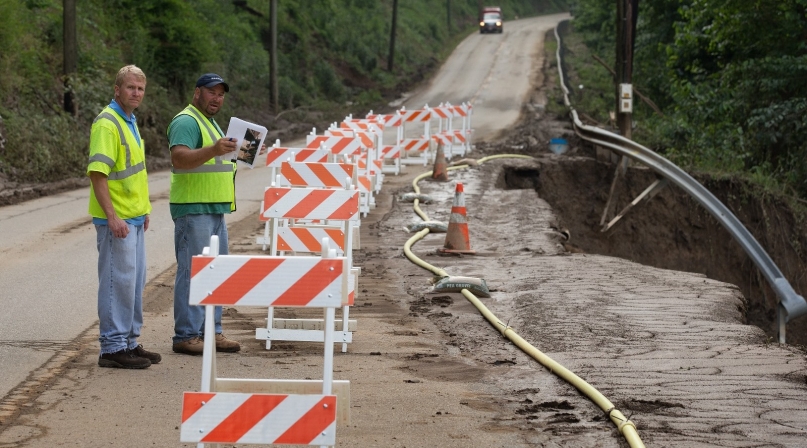June’s flash floods devastate hilly West Virginia counties

Flooding threatens W.V. small towns' survival
Before he rejoined the search for a Greenbrier County resident who had been missing for nearly two weeks since flash floods in West Virginia, Sheriff Jan Cahill acknowledged that things could have been even worse for the Mountain State.
It’s hard to believe, with 23 confirmed dead, one missing and hundreds of homes destroyed, mainly in the southeastern part of the state: destruction warranting presidential disaster declarations for Greenbrier, Kanawha and Nicholas counties.
“If this had happened at 3 or 4 in the morning, we would have seen more than 100 people die,” Cahill said. “People were up and about and they knew it was coming, even though they didn’t know how bad it would be.”
More than eight inches of rain fell the afternoon of June 22, after steady rain all day and most of the prior few weeks. The ground was saturated and there was nowhere for the water to go but up.
Crystal Young, executive assistant at the West Virginia Association of Counties in the state’s capital at Charleston, received a photo of Little Sandy Creek at the edge of her property that afternoon from her 16-year-old daughter, Ava. At 3:40 p.m., it was visible, but didn’t appear threatening.
Forty minutes later, the roads leading to the Young’s house in Clendenin were flooded but she drove through them anyway until a fallen tree stopped her. She told Ava, whose cell phone battery was down to 12 percent before the flooding started, to get to a nearby relative’s house, which she and her 15-year-old dog did with the aid of a passer-by. She spent the next day caring for 9- and 11-year-old relatives until being rescued by Young’s son.
“We lived in that house for 13 years, but we’re lucky,” Young said. “My daughter is safe, and we have a place to stay. We can replace things. My work family has been supportive, but it’s hard to think about the people who aren’t as fortunate, who don’t have places to stay and don’t know when things will change.”
Young doesn’t plan to return to Clendenin, a small town in rural Kanawha County. Her decision is one being agonized over by many, and may change the faces of some of these counties.
In Greenbrier County, Cahill said, “Some of [the towns] were on the ropes before the flood. I’m not sure if people will be coming back. Some might not even be able to rebuild in the same places.”
Jennifer Sayre, the Kanawha County manager, said Clendenin, though pretty flat, had water reaching 13 feet. The hilly topography compounded the saturating rainfall. Six people died in Kanawha County.
“The amount of water in some of these homes was unimaginable,” she said. “People were trapped on the second floor waiting for the water to recede.
“I’ve worked for the county for 16 years and I’ve never seen anything like it.”
Even the county ambulance authority station in Clendenin was completely flooded.
Cahill got the same reaction from residents in their 80s and 90s.
“They talk about the floods in 1985 and 1972, but this seemed the most dramatic to them,” he said. “They talk about 50-year floods and 100-year floods. I hope this was one of the 1,000-year floods.”
He was on the road when the rain got heavy.
“It’s like when you’re in your car in an automatic car wash, only five times more intense,” he said. “There was no visibility. I have never seen anything as intense or prolonged.”
Patti Hamilton, the executive director of the state association, was also on the road from the Canaan Valley when the rain started.
“It was just a torrential downpour for basically two-and-a-half hours,” she said. “I thought the storm was following me.”
She nearly stopped in a shopping center close to home that ended up being cut off from the road when its culvert bridges collapsed.
Young’s town, Clendenin, is one of several that some worry won’t be making a comeback.
Now, the region will try to rebuild.
Kanawha County has finished the emergency portion and has moved onto recovery. The most populous county in the state saw more than 1,500 families displaced.
In addition to helping residents work with FEMA, the county has been organizing debris cleanup, volunteers and coordinating drop-off sites and pickups, spending $600,000 from its emergency fund.
The County Commission waived building permit fees in affected areas.
Greenbrier County’s recovery hinges on the famous Greenbrier Hotel’s operation, not just as a magnet for outside income but because it is one of the largest employers.
The Greenbrier Classic golf tournament, scheduled to start 11 days after the flood, was cancelled, which, while sensible, put a hurt on residents who looked forward to part-time work.
The hotel has played host to displaced families for free, but now it has to get back into business.
“So many people work at the hotel, at the restaurants,” Cahill said. “They’re as worried about their jobs as they are their homes.”
Right now he’s worried about recovering the missing teenager to bring closure to her family, but he also fears there may be more casualties they haven’t found yet.
“We have been using airboats, cadaver dogs, drones, diving teams, people on foot — everything you can think of to search,” Cahill said.
Attachments
Related News

Counties directly eligible for $5.2 billion in competitive transportation grants
Counties are directly eligible for $5.2 billion in competitive transportation grants.

Join NACo in celebrating County Health Day on April 19, 2024
Please join NACo in celebrating County Health Day on Friday, April 19!

